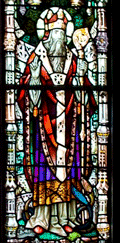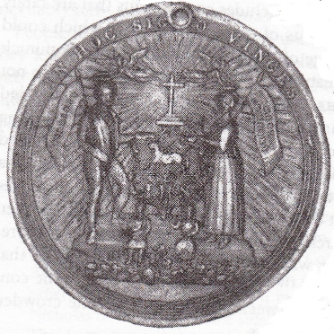KNOCK APPARITION: PERHAPS THE WITNESSES LIED?
On the night of the 21st of August 1879 the Virgin Mary flanked by St Joseph
and a bishop thought to be St John the Evangelist and an altar with a lamb
and cross on it allegedly appeared on the gable wall of the Parish Church of
Knock for a few hours. Fifteen people witnessed the vision including a child
of five (page 60, The Evidence for Visions of the Virgin Mary).
Witness statements were published in a highly altered and edited form that
differed hugely from the real ones the witnesses made. That the
witnesses didn't do the slightest thing about the lies speaks strongly
against them as honest people.
All the witnesses just mentioned what they saw. Could it be that they just
saw a magic lantern show and knew it? Could it be that their testimonies are
true and the fault for making a miracle out of the tale lies with the
interpreters?
The images they saw were described by many of them as statues. These people
did not protest when the Church lied that the appearances were of the Virgin
and Co as opposed to statues. They let the Church lie and thus were
complicit in those lies. Not one of the witnesses mentioned praying to the
images as if they were the real Mary etc. Bridget Trench supposedly tried to
touch the feet of the Mary statue and said thanks to God and Mary for the
manifestation. But she did not treat the entity as the real Mary or say it
was. She venerated the Mary image in the typical fashion when a devout
Catholic comes across a holy statue. Not one of the witnesses went to the
images to touch clothes and possessions and rosaries to them. This was
bizarre. Irish people of the time were fanatical about relics. Judith
Campbell's mother was dying so why didn't she bring a holy statue or
something from the house to touch it to the vision and then give it to her
mother in the hope of a cure?
They also let worshippers come with the intention of honouring the
apparition as an example of Mary and co coming to Knock in person. That is
idolatry for the apparition was of statues and statues cannot see or hear or
help you. Even Catholic teaching concedes that they cannot.
The Church took depositions from the witnesses about the apparition but made
no effort to get affidavits from the police or others as to the honesty of
the witnesses. The depositions cannot be taken seriously as evidence for a
genuine miracle with that question mark hanging over them.
THE RELATIONSHIP BETWEEN THE WITNESSES
Nine of the witnesses were related. Five of these people lived in the one
house (page 178, Knock The Virgin's Apparition in Nineteenth Century
Ireland). Mary Beirne, Margaret, Dominick Jun, Margaret the mother and the
niece Catherine Murray are the five (page 165, Knock The Virgin's Apparition
in Nineteenth Century Ireland). Dominick Beirne Sen and Patrick Hill were
relatives to the Beirnes.
Joseph Smith the fraudulent prophet of Mormonism got 8 witnesses to see the
golden plates. Their testimony is printed in at the start of the Book of
Mormon. It has been observed that their testimony is suspicious because of
the close family ties. Four were from the Whitmer family, one was a Whitmer
in law, and three were from Smith's own family. Why could Smith not get
strangers off the street to see the plates? Why did the circle have to be
too cosy for comfort? The testimony was written by Smith and they signed it.
The parallel with Knock is that the testimony is just as brief and general
as many of the Knock testimonies and it is known that the priests did not
write down the testimonies word for word as the witnesses gave their version
of events.
TESTIMONY OF THREE WITNESSES TO BOOK OF MORMON
Be it known unto all nations, kindreds, tongues, and people, unto whom this
work shall come: That we, through the grace of God the Father, and our Lord
Jesus Christ, have seen the plates which contain this record, which is a
record of the people of Nephi, and also of the Lamanites, his brethren, and
also of the people of Jared, who came from the tower of which hath been
spoken. And we also know that they have been translated by the gift and
power of God, for his voice hath declared it unto us; wherefore we know of a
surety that the work is true. And we also testify that we have seen the
engravings which are upon the plates; and they have been shewn unto us by
the power of God, and not of man. And we declare with words of soberness,
that an angel of God came down from heaven, and he brought and laid before
our eyes, that we beheld and saw the plates, and the engravings thereon; and
we know that it is by the grace of God the Father, and our Lord Jesus
Christ, that we beheld and bear record that these things are true. And it is
marvellous in our eyes. Nevertheless, the voice of the Lord commanded us
that we should bear record of it; wherefore, to be obedient unto the
commandments of God, we bear testimony of these things. And we know that if
we are faithful in Christ, we shall rid our garments of the blood of all
men, and be found spotless before the judgment-seat of Christ, and shall
dwell with him eternally in the heavens. And the honor be to the Father, and
to the Son, and to the Holy Ghost, which is
 one
God. Amen.
one
God. Amen.
TESTIMONY OF EIGHT WITNESSES TO BOOK OF MORMON
Be it known unto all nations, kindreds, tongues, and people, unto whom this
work shall come: That Joseph Smith, Jun., the Author and Proprietor of this
work, has shewn unto us the plates of which hath been spoken, which have the
appearance of gold; and as many of the leaves as the said Smith has
translated we did handle with our hands; and we also saw the engravings
thereon, all of which has the appearance of ancient work, and of curious
workmanship. And this we bear record with words of soberness, that the said
Smith has shewn unto us, for we have seen and hefted, and know of a surety
that the said Smith has got the plates of which we have spoken. And we give
our names unto the world, to witness unto the world that which we have seen.
And we lie not, God bearing witness of it.
These testimonies are useless because Smith himself wrote them and got them
to sign. There is no reason to believe all who signed agreed with what he
wrote. Just like the Knock testimonies, there was too much control taken
away from the alleged witnesses.
COLLUSION A POSSIBILITY
There is a serious problem as to why the vision was only witnessed by the
family and friends of Mary Beirne though there were plenty of other people
in Knock. Did she know that there was something odd about the whole thing
that made her afraid to go to unbiased people? Or was there a conspiracy to
say the vision had happened?
Collusion is possible because fifteen out of possibly twenty witness were
selected for questioning by the commission of investigation and they were
all connected. Five lived in the one house and were all relatives (page 165,
Knock The Virgin's Apparition in Nineteenth Century Ireland). Nine were
related.
The Beirnes were very close to Father Cavanagh and would naturally have
abhorred the threatening treatment he got from his parish (page 165, Knock
The Virgin's Apparition in Nineteenth Century Ireland). They were sacristans
of the Church. Most of the other visionaries were very devoted to the
priest. Witness Mary McLoughlin was the priest's housekeeper and a friend of
the Beirnes.
Why did a man born in Knock 1898 and why did Mary Beirne's son who was born
in Knock 1886 state that when they were growing up there nobody talked about
the apparition? (page 316, Knock The Virgin's Apparition in Nineteenth
Century Ireland). If people give a false testimony naturally they will give
it and want to give it no more except maybe to a few journalists or when
compelled to give it. Otherwise they put it out of their heads.
The old woman who witnessed the vision, Bridget Trench, wouldn't have liked
to say anything that contradicted the other witnesses because she depended
on them to feed her (page 191, Knock The Virgin's Apparition in Nineteenth
Century Ireland). Mary Mc Loughlin depended on her job as priest's
housekeeper which was a restriction on her. The priest supported the
apparition from the very morning after so that tied her tongue if she had
any fibs in relation to the claimed vision to confess.
Religion likes to present us with witnesses to miracles and argue that their
sincerity was proved when they endured great persecution and trouble for
their testimony. Such people will be regarded as strong witnesses. There are
so many conflicting miracle claims that we are forced to consider the ones
with the strongest testimony. Indeed that is what we should be doing anyway.
Does the apparition of Knock have this strong testimony?
No - they did not prove their sincerity by holding to their claims in the
face of ridicule and persecution. The Knock witnesses had no trouble at all.
In fact their lives were made better and their whole village was lifted
economically out of the sewers as a result of their claims. Strong
witnesses? I don't think so.
WHAT WERE THE VISIONARIES SET TO GAIN FROM THEIR TALE?
The witnesses would have seen the creation of a shrine at Knock as a means
to get out of dire poverty. An apparition gets attention put on your area's
problems. It also brings curiosity seekers and the devout and that alone
boosts the local economy.
Lourdes was revitalised economically by the 1858 apparition. The Archdeacon
had a huge devotion to Mary. So he would certainly have told the alleged
witnesses plenty about how Mary appeared at Lourdes, during Mass.
We read that when he first came to serve at Knock as priest, that the people
in the parish barely subsisted on what they had (page 36, Venerable
Archdeacon Cavanagh). Another factor causing this dire poverty was the poor
quality of the land (page 36, ibid). The year of the apparition 1879 was the
worst year in Knock since the Famine (page 64, Venerable Archdeacon
Cavanagh). The parish was malnourished and on the verge of famine as blight
had ravaged the potatoes. Typhus fever was rampant throughout the primitive
cabin houses (page 63, Venerable Archdeacon Cavanagh). These were people
that needed a miracle. And in the month of the apparition, the area was left
devastated because thanks to the heavy rains the autumn potato crop failed
(page 68, Venerable Archdeacon Cavanagh). We read that Archbishop Lynch of
Toronto went to Knock and wrote in 1882 that he saw great misery in Knock
and remarked how many families were evicted from their humble homes as three
failed harvests had meant they didn't have the rent money (page 80, 82,
Venerable Archdeacon Cavanagh). All the witnesses were set to indirectly
gain a lot from the vision.
Page 62, The Apparition at Knock, alludes to the fact that some of the
witnesses did gain from the vision directly
These things do not prove that they were dodgy. They do weaken the evidence
for the apparition. For example, if you say you see a supernatural being and
you turn that to your financial advantage, that suggests you may not have
seen the being at all for you don't have much respect for it or fear of it.
REASONS TO SUSPECT THERE WAS NOBODY AT THE GABLE THAT NIGHT!
The closeness of the "witnesses".
The Archdeacon did not see the light - at least that is what he said. He
should have noticed a glare at his bedroom window which faced the gable and
he supposedly went to bed early that night.
Patrick Walsh should have thought the Church was on fire when he saw the
light from a half a mile away. Why did nobody else from that distance or
more see it from their houses? Would he have really been out in the fields
in the dark on such a wet night? Indeed it is claimed from oral testimony ie
gossip that he thought somebody had lit a fire beside the Church (page 73,
The Apparition at Knock).
The fibs told by the Beirnes don't mark them out as very honest.
Margaret Beirne thought it was her job to lock the Church at a certain time
on the night of the apparition while Mary thought it was hers to do it at a
different time. One of these ladies was lying because they lived in the same
house and would not have had this confusion.
Another problem is that most of the Beirne visionaries lived in the same
house and yet you have Mary going to tell Dominick about the vision at 8 and
Catherine to tell Margaret at 8 and Margaret going back to tell her mother
at 8.15? (page 248, Knock The Virgin's Apparition in Nineteenth Century
Ireland).
Mary Mc Loughlin told the commission a lie that there was an apparition of a
cross. She denied it later and blamed the newspapers.
The way every account given to the commission is based on the framework of
Mary Beirne's testimony.
Did they pick a wet night when nobody neutral would be likely to have been
about so that they could lie about having been at the gable?
Irish people would not have let one of their number leave her mother
unattended in a house when she was dying. Judith Campbell did not leave her
mother and lied that she did. The nun of Kenmare who was close to the
witnesses wrote:
"it must also be remembered that the woman was left absolutely alone; that
she was believed to be actually in her agony."
She meant the final agony.
The dying and seriously ill are traditionally taken to holy shrines for a
cure. Why didn't they pick the old lady up and carry her to the gable
despite the rain?
Why was the priest not summoned that night to the bedside of dying Mrs
Campbell if she had made it out to her front door in an effort to see the
apparition and collapsed so that she was mistaken for dead?
Why didn't the police seem to know of the light? The barracks was only 300
yards away and had a view of the gable!
STORY STRAIGHT
The witnesses who were investigated had from August 21 to the date of the
investigation October 8th 1879 to get their stories straight and "remember"
it in a way that fitted what the others were saying.
In Ballyhaunis, there was a stained glass image of Mary and two others
standing in a pose reminiscent of the pose of the figures at Knock.
Below, you can see the image that apart from the colours in the robes could
be the bishop who appeared at Knock who was assumed to be Saint John. He has
the hand raised in the same way, wears a small mitre and even gazes in the
same direction as the Knock bishop did. The only major differences are that
he carries a crook not a gospel book and his robes are coloured and not pure
white.

The temperance medal image of a lamb on an altar with a cross behind matches what some the visionaries supposedly saw on the gable.

All the seers had to do to remember what to say was to recall the images on
the stained-glass window at the Roman Catholic Church at Ballyhaunis and the
altar and cross lamb on the temperance medal. These depicted the images at
Knock very closely - before the apparitions took place. There was a close
connection between Ballyhaunis and Knock (page 236, Knock The Virgin's
Apparition in Nineteenth Century Ireland).
The Archdeacon was one of the three or four priests chosen to investigate.
He was the chairman (182). The commission never took the testimony of the
seers word for word but changed it (page 182, Knock The Virgin's Apparition
in Nineteenth Century Ireland).
It is inexplicable that the witnesses who knew of pictures of St Patrick
holding his hand in blessing and wearing a mitre didn't think the bishop
figure was him. Someone manipulated the seers into thinking it was St John
the Evangelist. That person was Mary Beirne later Mary Mc Connell. That
they agreed when it should have been so unnatural for them to, shows how she
was getting into their minds. She was very effective.
"CONCLUSION"
Were they at the gable at all? The only evidence against collusion and
lies is that the witnesses did not make a huge deal out of their experience.
But the Archdeacon certainly did so they did not need to. And what if
they had regrets and doubts and dealt with them by keeping their heads down?
Not all fraudsters do all they can to gain from what they have done.





